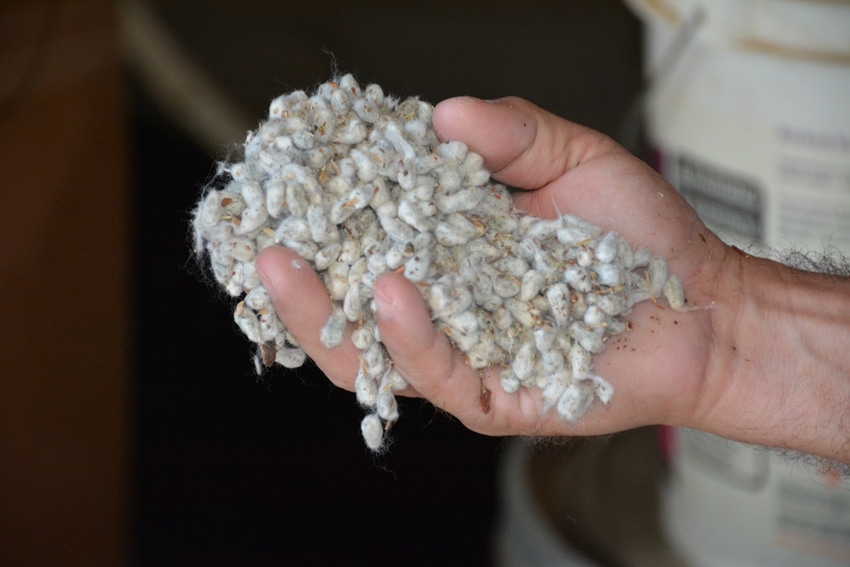
Cotton has the dubious distinction of having no national variety board to oversee seed certification standards, unlike some other crops.
Although cotton was one of the earliest crops for which the Association of Official Seed Certifying Agencies (AOSCA) developed certification standards, the association currently “does not administer a National Variety Board for cotton, as it does for some crops,” according to the organization’s website.
“Varieties enter into certification programs through a process conducted by individual seed certification agencies in those states where cotton is commonly grown,” its website notes. “AOSCA member agencies provide certification for seed that is grown following long-standing standards adopted for cotton. Member agencies from one coast to the other in the United States provide certification and inspection services for this important crop.”
Jason Woodward, Texas A&M Extension AgriLife pathologist at Lubbock, who spoke at the recent Beltwide Cotton Conferences at New Orleans, says, “We see a lot of differences across the industry.” A key issue in standardized certification across the cotton belt, he says, is to monitor seedborne pathogens, “which are a significant threat to the cotton seed industry.”
Woodward says he was not overly familiar with seed certification issues, but that he and Shawn Wade, Plains Cotton Growers, recently conducted a survey to evaluate seed certification procedures across the country.
REQUIREMENTS VARY
“Seed certification requirements vary across states and crops,” he says. “Varieties enter into certification programs that are conducted by individual state seed certification agencies.” Those include state Departments of Agriculture and Crop Improvement Associations, often affiliated with Land Grant Universities. Crop value, Woodward says, is a factor in the level of certification. Tolerances are at the discretion of seed companies.
The industry should be concerned, he says, about thresholds permitted for pathogens such as bacterial blight. He questions whether germination tests, which may include the typical germination evaluations as well as a cool-warm vigor index, should not look more closely at non-germinated seed to determine if microbes are associated with germination failures. “Should these low vigor seed be catalogued?”
Cotton farmers see seed vigor as a top priority
UAVs offer opportunity for Extension education
An industry standard would add a level of assurance of pathogen-free cotton seed. In seed production fields, certifiers or inspectors are often in the field, but the frequency is not standardized across the cotton belt.
“Timing of inspections is important,” Woodward says. Fields with disease-related issues are scrutinized, but he would go a step further. “A best management practice of zero tolerance, rejecting fields where diseases caused by seedborne pathogens are identified,” would be a good option.
PHYTOSANITARY INSPECTIONS
He says current industry standards tend to focus on bacterial blight and Fusarium wilt, but should include diseases such as Alternaria and Verticillium, among others. “The driving force seems to be related to international marketing (phytosanitary certificates). Phytosanitary inspections are required for international movement of seed. The countries targeted for sale trigger which diseases are being screened.”
Woodward and Wade reviewed several state cotton seed certification standards and found significant differences.
Diseases are a more complex issue to consider in seed certification than seed quality, seed purity, weed seed, and inert matter. “Those are low-hanging fruit,” Woodward says. “Disease identification and isolation are more difficult.”
For the latest on southwest agriculture, please check out Southwest Farm Press Daily and receive the latest news right to your inbox.
He says seed certification is important to the industry, including producers, to assure high quality planting seed. “Use of certified seed helps protect the buyer, providing a guarantee that seed meets a standard level of high genetic purity, germplasm identity, high germination rates, and a minimal amount of other crop seed, weed seed, and inert matter.”
Changes in cotton varieties over the past 20 years have resulted in changes in certification procedures, Woodward says. And those changes present new challenges. “Language between state procedures differs drastically, and AOSCA certification procedures are not easily obtainable.”
He says involvement of state agencies varies across the country and adds that a crucial question is how inter-state agencies interact regarding movement of certified seed.
About the Author(s)
You May Also Like






